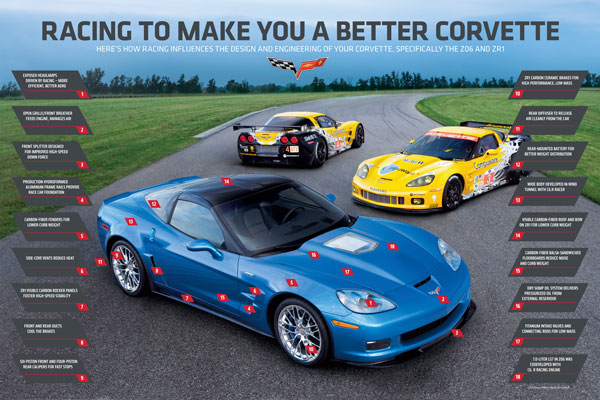C6 Corvette Inspired by Racing
Click on the image for full-size 18 Reasons Resemblance to the C6.R is More Than Skin Deep
18 Reasons Resemblance to the C6.R is More Than Skin Deep
by Jason Giacchino
Since its introduction back in 1953, there has never been a Corvette that didn’t showcase Chevrolet’s innermost desires of performance and world-class ambition (even in those dark days of the early 1980s). To many, the 6th and current generation Vette (2005-present) is an automobile truly worthy of GM’s lofty aspirations.
However, playing with the race-proven likes of Ferrari, Lamborghini and Porsche requires a good deal of innovation, literally born and proven on the racetrack. According to GM, that is precisely the C6 formula for success, specifically concerning the Z06 & ZR1 configurations.
In fact the above graphical representation covers a whopping 18-aspects of Vette tech that have resulted from racing’s influence:
1) Exposed Headlamps: Literally crafted as a part of the vehicle’s aerodynamic structure, paying dividends in high-speed stability and reduced friction drag in an arena where hundredths of a second can separate winners from the rest of the pack.
2) Open Grille/ Air Intake: Forced air induction works on the simple premise that as speeds increase, the amount of air entering the engine increases.
3) Front Splitter: Downforce works on the principle that the very air around the vehicle can be converted into increased vertical force on the tires, thus creating additional grip.
4) Hydroformed Aluminum Frame Rails: Chassis rigidity all begins with the frame. Hydroformed aluminum blends an unbeatable combination of strength with lightweight characteristics.
5) Carbon Fiber Fenders: Fiberglass simply can’t compete with carbon fiber’s ability to look spectacular while lowering curb weight.
6) Side Cove Vents: To whisk away excess engine heat using the vacuum created in the machine’s wake.
7) ZR1 Carbon Rocker Panels: Further increasing high-speed stability by the redirection of airflow.
8) Front & Rear Cooling Ducts: It is said you are only as fast as you can stop and in braking, heat is always the enemy. Cooling ducts ensure strong, consistent performance.
9) Calipers: Keeping the brakes cool should not be discounted, but getting the C6’s massive rotors down from speed is a task best handled by six-piston front and four-piston rear calipers.
10) Carbon Ceramic Brakes: ZR-1 actually goes a step further in the braking department by implementing carbon ceramic brakes for unrivaled performance/ decreased mass.
11) Diffuser: Rear diffuser improves the car’s aerodynamic properties by enhancing the transition between the high-velocity airflow underneath the car and the much slower stream of the ambient atmosphere while extracting exhaust from below the car.
12) Battery Mounting: To aid in weight distribution, the C6 battery is mounted in the rear of the vehicle.
13) Body: If the C6 looks eerily reminiscent to the C6.R Racecar, that’s because the body itself was developed in the wind-tunnel using data collected from the C6.R.
14) Carbon Fiber: The ZR1’s curb weight is even further reduced by use of carbon fiber in the bow and roof.
15) Floorboards: Carbon fiber/ balsa-sandwiched floorboard construction not only decreased cockpit noise, but aids in lowering curb weight as well.
16) Oil: Dry sump system draws pressurized oil from an external reservoir ensuring oil reaching the engine is cool.
17) Titanium Bits: Both connecting rods and intake valves are constructed of titanium for strength and reduction of mass.
18) Engine: Just like with the body, the C6 Corvette’s 7.0-Liter LS7 engine package was developed in conjunction with the C6.R Racecar’s power plant.
It is often said that the technology of auto racing today ends up becoming the standard equipment of the streetcars of tomorrow but when it comes to the Corvette, Chevy begs the question, what’s the sense in waiting?
